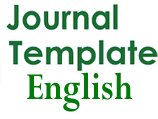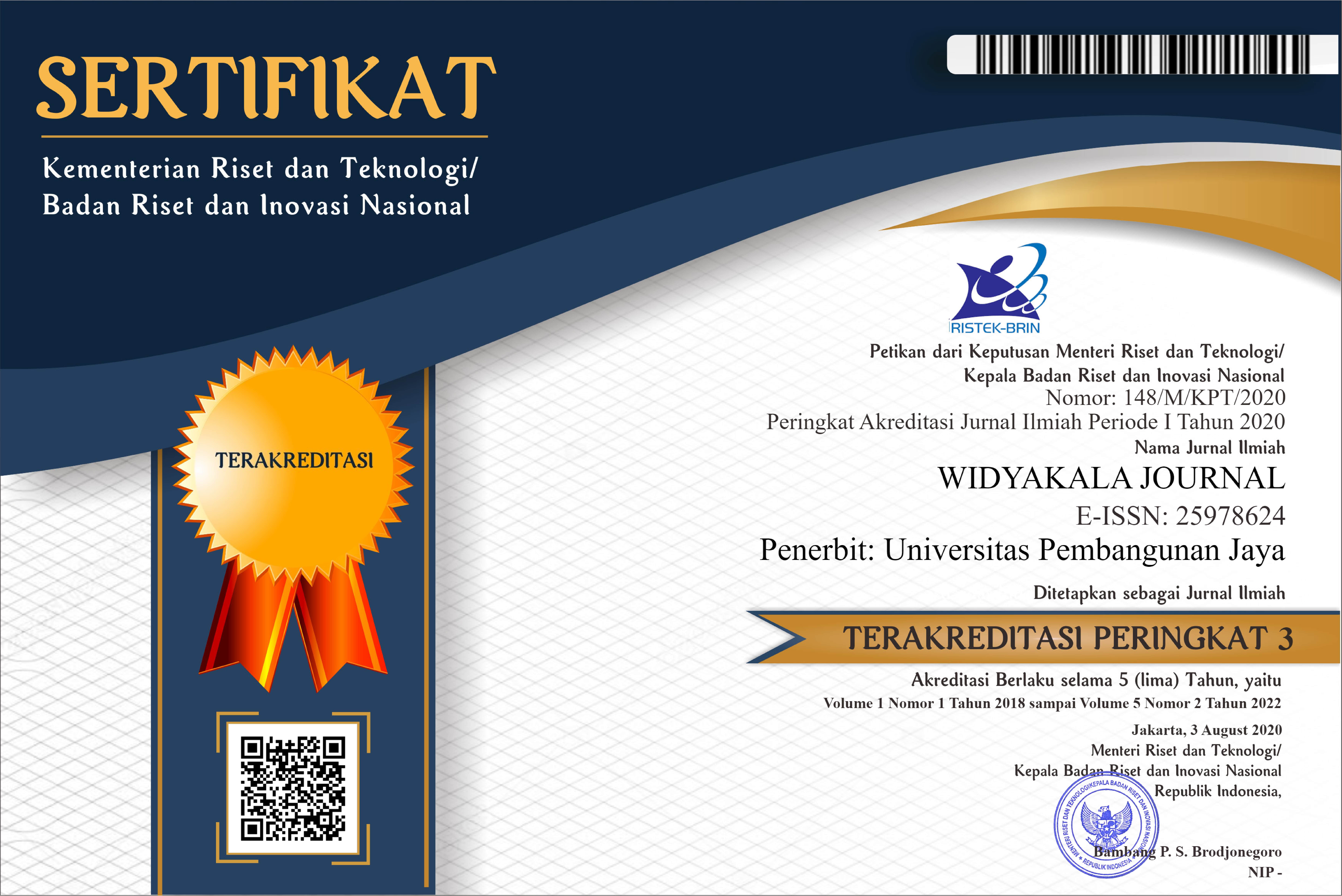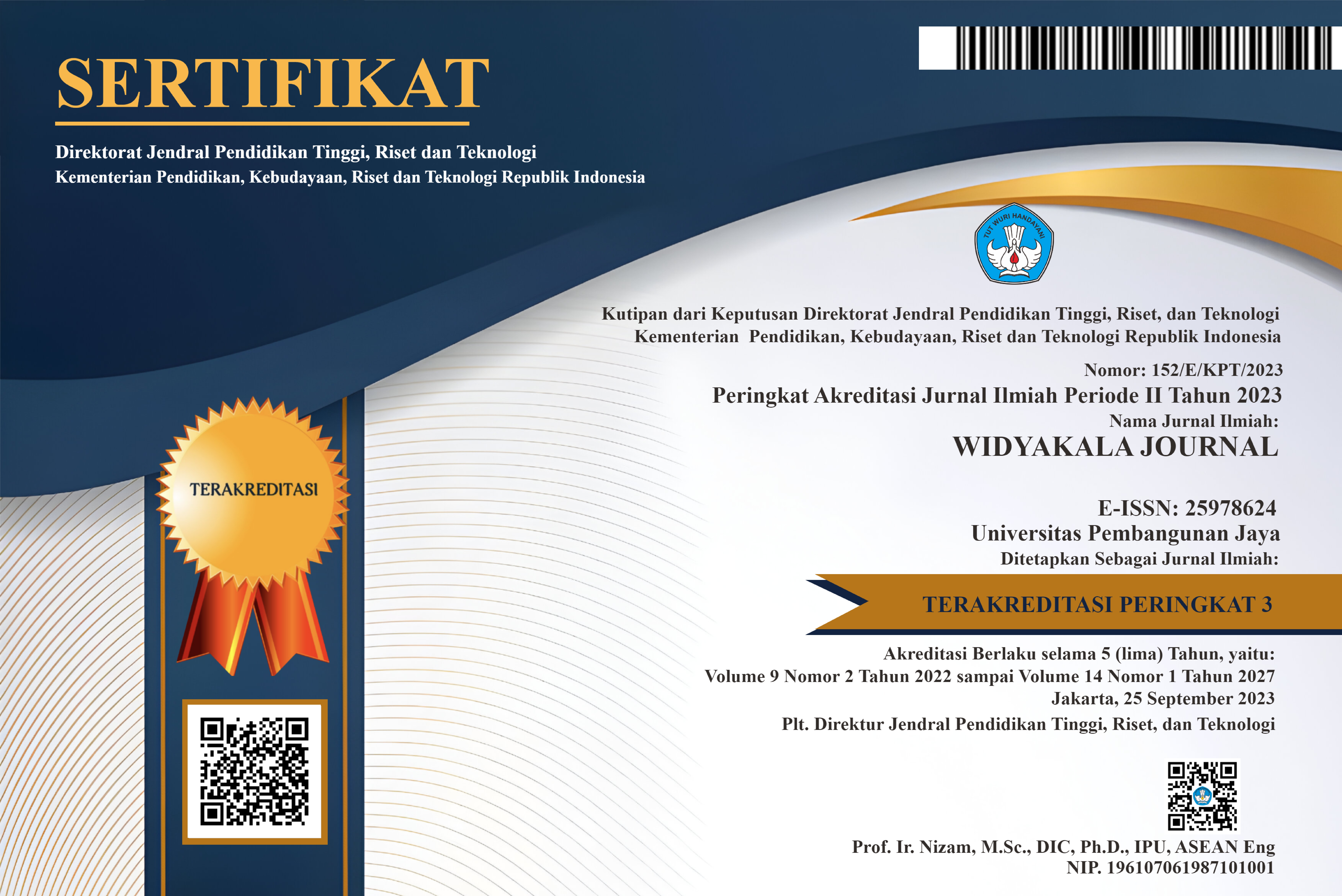Updated, December 20th, 2023
Assessing Financial Performance in Consumer Goods Manufacturing: The Role of Debt to Assets Ratio, Current Ratio, and Inventory Turnover
Abstract
Manufacturing companies in the consumer goods sector play a vital role in satisfying market demands and attracting investors, especially those listed on the Indonesia Stock Exchange (IDX). This study assesses the financial performance of consumer goods manufacturing companies listed on the IDX, focusing on the cosmetics and household goods sub-sector. It examines the influence of Debt to Assets Ratio (DAR), Current Ratio (CR), and Inventory Turnover on financial performance. Data analysis utilizes panel data regression tests. Findings reveal that all three variables significantly impact financial performance, suggesting that managing these ratios can enhance company profitability and value. The study offers practical recommendations for improving asset management, liquidity, and inventory turnover to optimize consumer goods manufacturing sector financial performance.
Keywords
Full Text:
PDFReferences
Wolf, C. A., Stephenson, M. W., Knoblauch, W. A., & Novakovic, A. M. (2016). Dairy Farm Financial Performance: Firm, Year, and Size Effects.
Ahrendsen, B. L., & Katchova, A. L. (2012). Financial ratio analysis using ARMS data. Agricultural Finance Review, 72(2), 262–272. https://doi.org/10.1108/00021461211250492
Arisadi, Y. C. (2013). Pengaruh Ukuran Perusahaan, Umur Perusahaan, Current Ratio, Debt toEquity Ratio dan Fixed Asset to Total Asset Ratio terhadap KinerjaKeuangan pada Perusahaan Manufaktur di Bursa Efek Indonesia.
Assenga, M. P., Aly, D., & Hussainey, K. (2018). The impact of board characteristics on the financial performance of Tanzanian firms. Corporate Governance (Bingley), 18(6), 1089–1106. https://doi.org/10.1108/CG-09-2016-0174
Ballou, R. H. (2000). Evaluating Inventory Management Performance Using a Turnover Curve. International Journal of Physical Distribution and Logistics Management, 30(1), 72–85. https://doi.org/10.1108/09600030010307993
Britney, R. R. (1980). Growth, Product Lines and Realistic Inventory Turns.
Chan, T. K., & Abdul-Aziz, A. R. (2017). Financial Performance and Operating Strategies of Malaysian Property Development Companies During the Global Financial Crisis. Journal of Financial Management of Property and Construction, 22(2), 174–191. https://doi.org/10.1108/JFMPC-02-2016-0009
Chen, L.-H., Liaw, S.-Y., & Chen, Y. S. (2001). Using financial factors to investigate productivity: an empirical study in Taiwan. http://www.emerald-library.com/ft
Dobbins, R. (1993). An Introduction to Financial Management. Management Decision, 31(2), 5–110. https://doi.org/10.1108/00251749310031851
Dunk, A. S. (2005). Financial and Non-Financial Performance: The Influence of Quality of Information System Information, Corporate Environmental Integration, Product Innovation, and Product Quality. In Advances in Management Accounting (Vol. 14, pp. 91–114). https://doi.org/10.1016/S1474-7871(05)14004-0
Etikan, I. (2016). Comparison of Convenience Sampling and Purposive Sampling. American Journal of Theoretical and Applied Statistics, 5(1), 1. https://doi.org/10.11648/j.ajtas.20160501.11
Feronicha, A., Efendi, W., Sulaksono, S., & Wibowo, A. (2017). Sektor Keuangan Yang Terdaftar Di Bursa Efek Indonesia. Journal of Applied Managerial Accounting, 1(2), 157–163.
Gadanakis, Y., Stefani, G., Lombardi, G. V., & Tiberti, M. (2020). The Impact of Financial Leverage on Farm Technical Efficiency During Periods of Price Instability. Agricultural Finance Review, 80(1), 1–21. https://doi.org/10.1108/AFR-09-2018-0080
Ghasemi, A., & Zahediasl, S. (2012). Normality tests for statistical analysis: A guide for non-statisticians. International Journal of Endocrinology and Metabolism, 10(2), 486–489. https://doi.org/10.5812/ijem.3505
Ghozali, I. (2018). Aplikasi analisis multivariate dengan program IBM SPSS 25. http://slims.umn.ac.id//index.php?p=show_detail&id=19545
Harahap, I. M., Septiani, I., & Endri, E. (2020). Effect of financial performance on firms’ value of cable companies in Indonesia. Accounting, 6(6), 1103–1110. https://doi.org/10.5267/j.ac.2020.7.008
Ho, C. T. B. (2004). Performance Evaluation of Australia’s Major Banks. In Asian Review of Accounting (Vol. 12, Issue 1, pp. 19–33). https://doi.org/10.1108/eb060771
Iqbal, M., Khan, S., Ullah, S., & Zeb, A. (2016). Effect of Liquidity and Capital Structure on Financial Performance: Evidence from banking Sector Effect of Liquidity and Capital Structure on Financial Performance: Evidence from banking Sector.
Isaac, E. (2023). Convenience and Purposive Sampling Techniques: Are they the Same? www.seahipaj.org
Jones, S. (2005). Financial Analysis: Applications to Australian Toll Road Entities.
Kartika Prananingrum, D., Azis Muthalib, D., Irfandy Azis, M., & Rohansyah, M. (2018). Effects of Return on Asset, Return On Equity, Earning Per Share on Corporate Value. https://doi.org/10.9790/1813-0703010614
Katchova, A. L., & Enlow, S. J. (2013). Financial Performance of Publicly-Traded Agribusinesses. Agricultural Finance Review, 73(1), 58–73. https://doi.org/10.1108/00021461311321311
Krisnandi, H., Awloedin, D. T., & Saulinda, S. (2019). Pengaruh Current Ratio, Inventory Turnover, Debt to Equitu Ratio, dan Ukuran Perusahaan Terhadap Kinerja Keungan Perusahaan.
Kropp, J. D., & Katchova, A. L. (2011). The effects of direct payments on liquidity and repayment capacity of beginning farmers. Agricultural Finance Review, 71(3), 347–365. https://doi.org/10.1108/00021461111177611
Liu, C. M., O’Farrell, G., Wei, K. K., & Yao, L. J. (2013). Ratio analysis comparability between Chinese and Japanese firms. Journal of Asia Business Studies, 7(2), 185–199. https://doi.org/10.1108/15587891311319468
Maisharoh, T., & Riyanto, S. (2020). Financial Statements Analysis In Measuring Financial Performance of PT. Mayora Indah Tbk, Period 2014-2018. In Journal of Contemporary Information Technology, Management, and Accounting (Vol. 1, Issue 2).
Mbona, R. M., & Yusheng, K. (2019). Financial Statement Analysis: Principal Component Analysis (PCA) Approach Case Study on China Telecoms Industry. Asian Journal of Accounting Research, 4(2), 233–245. https://doi.org/10.1108/AJAR-05-2019-0037
Needles, B. E., Shigaev, A., Powers, M., & Frigo, M. L. (2010). Strategy and integrated financial ratio performance measures: A longitudinal multi-country study of high performance companies. Studies in Managerial and Financial Accounting, 20, 211–252. https://doi.org/10.1108/S1479-3512(2010)0000020011
Neetij, & Bikash Thapa, R. (n.d.). A Study on Purposive Sampling Method in Research. http://study.com/academy/lesson/what-is-sampling-in-research-definition-methods-importance.html,
Ozgulbas, N., & Serhan Koyuncugil, A. (2006). Application of Data Mining Method for Financial Profiling. Social Responsibility Journal, 2(3–4), 328–334. https://doi.org/10.1108/17471117200600010
Rani, N., Yadav, S. S., & Jain, P. K. (2015). Financial performance analysis of mergers and acquisitions: evidence from India. International Journal of Commerce and Management, 25(4), 402–423. https://doi.org/10.1108/IJCoMA-11-2012-0075
Riduwan, & Koncoro, E. A. (2012). Cara Menggunakan Dan Memakai Analisis Jalur (Path Analysis). Bandung: Alfabeta.
Schellhorn, C., & Sharma, R. (2013). Using the Rasch model to rank firms by managerial ability. Managerial Finance, 39(3), 306–319. https://doi.org/10.1108/03074351311302818
Sekaran, U., & Bougie, R. (2016). Research Methods for Business : a Skill-Building Approach (7th ed.). United Kingdom: Wiley.
Sitohang, A. W., & Wulandari, B. (2020). Pengaruh Current Ratio, Debt To Equity Ratio, Earning Per Share, terhadap Kinerja Keuangan. Journal of Education, Humaniora and Social Sciences (JEHSS), 3(2), 577–585. https://doi.org/10.34007/jehss.v3i2.361
Subarjo, & Sari, F. W. (2017). Analisis Turnover Terhadap Kinerja Keuangan Dengan Revenue Sebagai Variabel Moderasi (Studi Pada PT. Madukismo Yogyakarta Tbk).
Sugiyono. (2008). Metode Penelitian Pendidikan : (pendekatan kuantitatif, kualitatif dan R & D) (6th ed.). Bandung: Alfabeta.
Sunyoto, D. (2016). Metodologi Penelitian Akuntansi. Bandung: PT Refika Aditama Anggota Ikapi.
Suvvari, A., Raja Sethu Durai, S., & Goyari, P. (2019). Financial performance assessment using Grey relational analysis (GRA): An application to life insurance companies in India. Grey Systems, 9(4), 502–516. https://doi.org/10.1108/GS-05-2019-0010
Syafitri, L. (2015). Pengaruh Inventory Turnover Dan Total Asset Turnover Terhadap Profitabilitas Pada CV. Teluk Kenanga Ogan Ilir.
Tikasari, N., & Surjandari, D. A. (2020). The Effect of Economic Value Added and Financial Performance on Stock Return. Saudi Journal of Business and Management Studies, 5(6), 343–352. https://doi.org/10.36348/sjbms.2020.v05i06.005
Widarjono, A. (2007). Ekonometrika: teori dan aplikasi untuk ekonomi dan bisnis (2nd ed.). Yogyakarta: Ekonisia FE Universitas Islam Indonesia.
Widnyana, I. W., Wiksuana, I. G. B., Artini, L. G. S., & Sedana, I. B. P. (2020). Influence of Financial Architecture, Intangible Assets on Financial Performance and Corporate Value in The Indonesian Capital Market. International Journal of Productivity and Performance Management. https://doi.org/10.1108/IJPPM-06-2019-0307
Winand, M., Zintz, T., & Scheerder, J. (2012). A financial management tool for sport federations. Sport, Business and Management: An International Journal, 2(3), 225–240. https://doi.org/10.1108/20426781211261539
Yuliara, I. M. (2016). Regresi Linear Berganda.
DOI: https://doi.org/10.36262/widyakala.v11i1.999
Refbacks
Copyright (c) 2024 WIDYAKALA JOURNAL : JOURNAL OF PEMBANGUNAN JAYA UNIVERSITY

This work is licensed under a Creative Commons Attribution-ShareAlike 4.0 International License.
Redaksi Jurnal Widyakala
Lembaga Penelitian dan Pengabdian Kepada Masyarakat (LP2M)
Universitas Pembangunan Jaya
Jalan Cendrawasih Raya Blok B7/P, Sawah Baru, Ciputat, 15413
Telp : 021-7455555 ext 1311
widyakala.journal@upj.ac.id


















